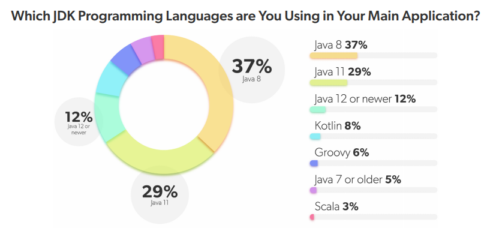
A majority of Java developers are planning to make the move to the latest Long-Term Support (LTS) version of the language. According to JRebel’s 2022 Java Developer Productivity Report, 62% of developers plan to switch within the next 12 months.
According to the survey, Java 8 is currently the most used version in production at 37%, followed by Java 11 at 29%. Both of these are LTS releases. Only twelve percent of developers are using Java 12 or later.
A quarter of survey respondents cite long-term support as the factor that most influences their decision to upgrade to newer versions. Other factors include security at 23% of respondents, performance at 20%, new features at 18%, and compliance reasons at 14%.
RELATED CONTENT: Java 17 released with updates to LTS schedule
When comparing the likelihood of upgrading to Java 17 among companies of different sizes, JRebel found that companies with fewer than 100 employees are more likely to make the move than larger companies. JRebel speculates that this is due to the complexity and cost of upgrading large enterprise Java applications.
The survey also looked at the adoption of commercial versus open Java distribution and found that Oracle Java was adopted by 36% of respondents, OpenJDK was adopted by 27%, and AdoptOpenJDK/Adoptium was adopted by 16%.
“Given the large representation from larger companies in this survey, it’s not surprising to have an even split between commercial and open source JRE/JDK distributions. Commercial distributions like Oracle Java can give larger organizations an easy way to source patches and updates. For many large organizations, avoiding the hassle of doing that work in-house is worth the price tag,” JRebel wrote in the report.
Another interesting finding of the report is that microservices is the most popular architecture for Java applications, at 32%. Only 22% use a monolith and 8% use a serverless architecture. Spring Boot is by far the most popular microservices framework, with 74% of respondents using it.






